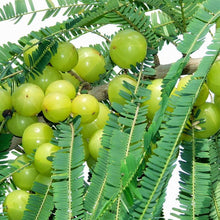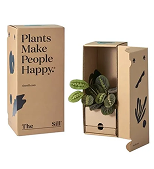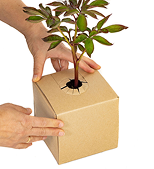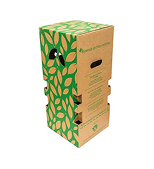- Home
- Flowerings
- Amla Banaras(Grafted)- Fruit Plants
Amla Banaras(Grafted)- Fruit Plants













Amla Banaras(Grafted)- Fruit Plants

 Climate
Climate Time to yield
Time to yield Maximum size
Maximum size


Grafted for faster yield within 12-18 months.

Damaged or lifeless? We’ll replace it for free. Learn more




Double layered custom boxes to protect plants during shipping.

Air vents for proper air-flow

To preserve plant freshness during transit

Details steps of how to grow and maintain your plant
Amla is Botanically known as Phyllanthus emblica from the phyllanthaceae family. It is quite hardy, prolific bearer, and much remunerative even without much care. It is also known as Indian gooseberry amlaki, amla, amia, amali, ambala, nelli,etc. Its importance lies in its high richness of vitamin C. It is the second-highest source of vitamin C among fruits next only to Barbados cherry.
Banarasi Variety - It is the oldest early maturing variety of amla. The fruit weight is 45-50 g per fruit. It has a light yellow color and six segments that appear as joined together is one of the characteristic features of this variety. Fruits are generally used for making murabba (preserve), candy, etc.
MAXIMUM HEIGHT - It can reach up to 2-5 meters if planted in the ground.
BLOOMING TIME - It blooms twice a year in many parts of India in winter & summer, sometimes it varies based on the climate of a particular area.
FRUITING TIME - Edible fruiting will start from 1 year after purchase.
GROWING TIPS -
- Select the sunny spot in your garden (4-6hours of sunlight). It is a very wild plant, grows in a variety of soil, but the soil should be well-drained & fertile.
- You can grow it in medium to big size pot, but directly in the ground is always best. Provide support in the initial days against wind & wild animals.
- Water it regularly in the summer & reduce the watering in winter.
- Provide organic mulch in the pot or near the plant base to protect to prevent moisture evaporation & weed growth.
INSIDE THE BOX
| S.No. | PRODUCT NAME | DIMENSION |
| 1. | Amla Banaras(Grafted) | 2-3 Feet Height |
| 2. | Growing Pot (Black color) | 6 Inch |
*above specifications are for indicative purposes only, actual dimensions may slightly vary.
PLANT CARE
LIGHT CONDITION - More than 6 hours of Direct Sunlight.
WATERING SCHEDULE - Water when the topsoil(2-3inch) feels dry to touch. Always maintain moisture near the root zone.
SOIL TYPE - The soil should be well-drained, fertile & rich in organic content. Amla plants can grow in almost all types of soil.
FERTILIZER APPLICATION - Initially up to 1 year apply any organic fertilizer once a month. After full establishment apply any organic fertilizer before the flowering season only.
PLANT PROTECTION - Generally it doesn't affect major pests so, apply Neem Oil if found any attack of insects & pests for primary treatment.
INITIAL CARE FOR 10-15 DAYS JUST AFTER RECEIVING YOUR PLANT
- Remove the Packaging Materials carefully.
- Press the soil in the pot & add additional soil(garden mix) if necessary.
- Maintain moisture in the pot, Do not overwater it may kill your plant, so make sure that the soil should be dry between watering.
- Provide support with stick/moss stick(vine plant) in order to make straight growth, for needed plant only.
- Make sure that plants get enough indirect bright light for 10-15 days & do not go for immediate transplanting(minimum 1-2 months)
- Just prune if any branch of the plant is get damaged in transit. It happens very rarely.
- In the case of Grafted Plant, if found any shoots arising from below the grafting portion then prune it immediately.
Selected plant of 8-10 inches
Planted into a 5-inch pot
With healthy, moisture-retaining soil
A care instruction sheet for maintenance guide

Get in touch for best pricing on bulk orders and landscaping projects.
 WhatsApp us
WhatsApp us

Call on 9177805454 (Mon-Sat, 9 AM-6 PM) or WhatsApp us – we’re here to help.
About Exotic Flora
At Exotic Flora, we’re passionate about bridging the gap in bringing plants to everyone. With over 500+ varieties across 7 plant categories, from exotic finds to everyday greens, we bring the entire range to you.
Our plants, sourced from all parts of India are nurtured at Kadiyam, in our 25 acres in-house nursery by a team of expert horticulturists. Once they are ready we ship all our plant varieties across India.
Our services go beyond safe delivery of plants. A dedicated support team is there to help you with any maintenance queries you may have.
At Exotic Flora we always believe in going that extra mile, because everyone should have the plants they love.
Every, fruit plants vary in their fruiting time, depends on location, climate & age of the plants. Generally, Grafted fruit plants starts fruiting within 2 years of planting, where as non-grafted plants take more than 2 years. You can check the fruiting time of each plant in the plant description.
No, Majority of fruit plants are not delivered with fruits. But some grafted fruit plants can be delivered with fruits and flowers mostly Citrus, Guava, Star fruit, Fig, Ber etc. But it is recommended to remove the flowers during early days, so that plants can get more branches and physical strength.
Grafting is a technique where two plants part are combined together so that they can grow together. Most commonly seen in Mango. Air Layering is also a vegetative propagation technique where a plant is produced while it is still attached to its parent's plants. Commonly seen in Guava. Stem cutting is a vegetative propagation technique, where soft, semi-hard, or hardwood stem is cut with 2-3 nodes and used for the multiplication of plants. Commonly seen in flowering & ornamental plants.
Yes, the grafted fruit trees produce fruit earlier, than the non-grafted fruit plants.
These are some of the rare and new fruit plants and it's varities, which are not avialable everywhere in our country.
Remove the plant from its pot. Make sure to not disturb the root ball. Place the plant in a prepared pit(1x1ft) or slightly bigger pot than the current pot. Firm the soil around the plant with your hands. Water well till it drains out from the drainage hole.
In order to maintain the good shape of the plants, proper care should be taken from the beginning like the pruning of unwanted and diseased parts of plants, stalking to young plants, regular maintenance of plants.
In General, a grafted/air layered/hybrid fruit takes 2 years for fruiting, whereas seeded grown plants take 4-5 years of time for fruiting. But it may vary depending on the plant types.
In general if your soil weell drained, fertile and organic in nature, it will produce good quality fruit. Sandy-loamy is the most preferable soil used for fruit plants.
Size and taste of each fruit plants varies depending on the varieties. You can find more details about each fruit plants in terms of size and taste in the description of individual plants.
Initial first 2 years are very important to feed the plants with organic manure and fertilizers regularly. It is recommended to add organic manure or compost to each plant in every 3 months of time intervals. Do not go for Chemical fertilizers it will weaken the plants in future.
Plastic pots with drainage holes preferably work best as they are lighter to move around. Any other container which is light in weight with a drainage hole can also work to grow fruit plants.
Will Update after 1 month
.
Good Quality Plant and delivered with due care. Many Thanks ... Ravindra Nivrutti Nigade from Gulunche - Pune - Maharashtra
Received healthy plant
